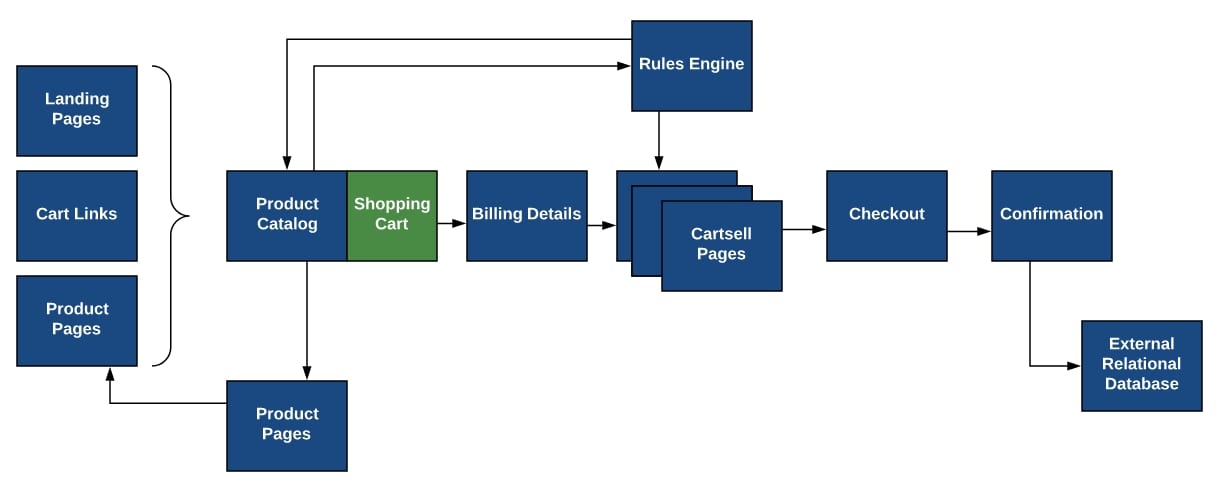Background on my ecommerce sales funnel
Ecommerce sales funnels are designed to guide a consumer through the purchase process and present them with value-added offers that compliment their existing purchase before they checkout.
I architected and had developers build my ecommerce sales funnel. Rather than use an existing solution, I went this route because of the following:
- I could not find a customizable ecommerce cart to turn into a sales funnel;
- Which fits with WordPress;
- That can accomodate a multi-product ecommerce setup;
- That is “smart” and can be personalized based on what the customer has or does not have in their cart;
- Whose data from the sale can be sent to an external database;
- All done cost-effectively (there are enterprise-level systems I have used that can do this, but they are far too expensive for startups or small consumer product companies);
- And, once built, allows me to change the funnel sequences and build the upsell/crossell/downsell pages on my own without having to engage with my developer every time. This is a huge requirement because in the past, every time I wanted to change anything in my sales funnel, I would have to engage with my developer, which added cost and time. By having the ability to do it all myself, I save money and can do things quickly myself.
I designed the flow and requirements, summarized in the diagram below, and had developer’s code this into Woocommerce.
What makes my ecommerce sales funnel “smart”?
What makes this ecommerce sales funnel smart is the rules engine I had built. It works as follows:
- Based on what the customer has or does not have in the cart, the cartsell pages will show through guidance with a rules engine.
- The cartsell pages are upsells, crossells and downsells; they are just single wordpress pages.
- For example, full priced items can be shown in the product catalog page, which is the start of the ecommerce sales funnel and cart checkout process. The product catalog page also has a dynamically updating cart to show the customer what is in their cart based on what is added from the product catalog page.
- If the customer selects to purchase them, then cartsell pages on those products will not be shown. If the customer does not have the full price item in their cart, a cartsell page with an offer for a discount can be show to entice the customer to purchase.
- Based on what the customer accepts or does not accept in the cartsell pages, the rules engine can be further customized to change the cartsell page flow.
- Each cartsell page is a dedicated landing page promoting a product or offer.
- I build my cartsell pages and group them under a parent page (like the shop page) and also order them to keep them organized and together in the pages view in WordPress.
- There is a priority list so that if a cart contains more than 1 product that has a rules sequence attached to it, then the rules sequence for the highest level priority product will be shown first.
Following checkout, I use the Zapier plugin to send the customer information and purchase data to an external relational database, which is my central warehouse for all my customer transactions, marketing and CRM data.
The rules engine is a single PHP page. To keep it lightweight, I did not build a front-end to it. Once it was built and initial rule sequences built in, if I want to add a sequence, I just copy and paste a section of the code with the sequence I want and change the page ID’s. This allows me to add, delete or adjust sequences based on the models already created on my own without having to engage with my developer. I can read PHP code, so it is not that hard once I grab the sequence I want.
For example, one rule sequence contains three upsells, and one downsell. If I want to create a new rules sequence with this 3-1 format, I just copy it from an existing rules sequence, paste it in the PHP document in the location I want and comment as needed to keep it organized. Then, I change the wordpress page ID numbers in this copied sequence to match how I want the sequence to go.
Eazy peazy.
The results
After a year of having the ecommerce sales funnel operational, on average, 13% of customers that enter the ecommerce cart add an upsell, crossell or downsell to their cart.
That is an across the board average.
Some products have higher averages and some have lower.
But I think my overall upsell/crossell/downsell results is much better because I have noticed that some customers which do not accept either in the checkout flow end up making a purchase of one of the upsell/crossell/downsell products later on.
I can’t necessarily attribute that follow-on purchase to the original upsell/crossell/downsell display in the sales funnel because I am marketing many of my upsell/crossell/downsell products across different channels to the customer (website, email, snail mail, events).
But the ecommerce sales funnel is just another channel to advertise upsell/crossell/downsell products, even if they do not accept it at the time of checkout.
My ecommerce sales funnel is in operation in my pet category company here.





